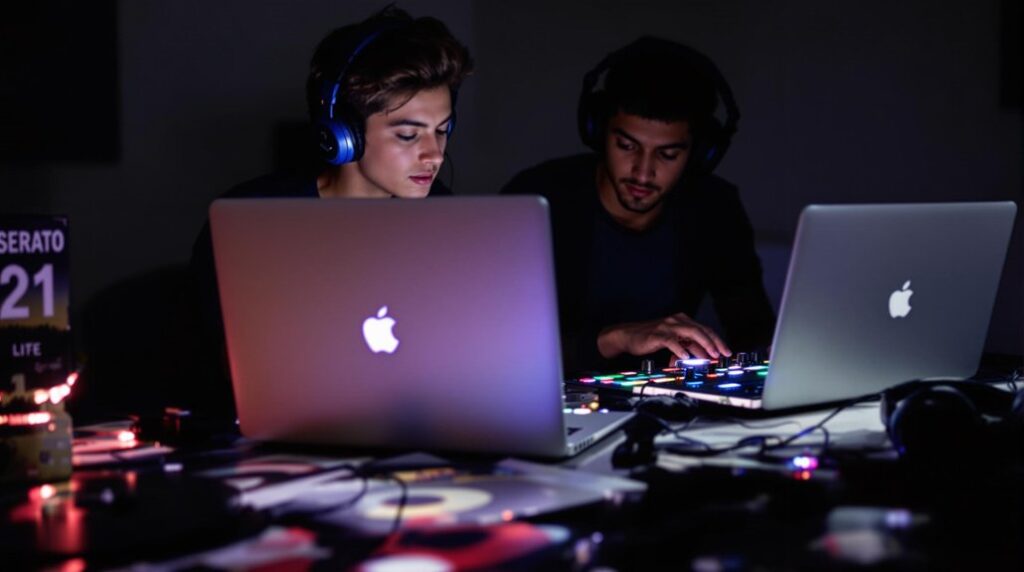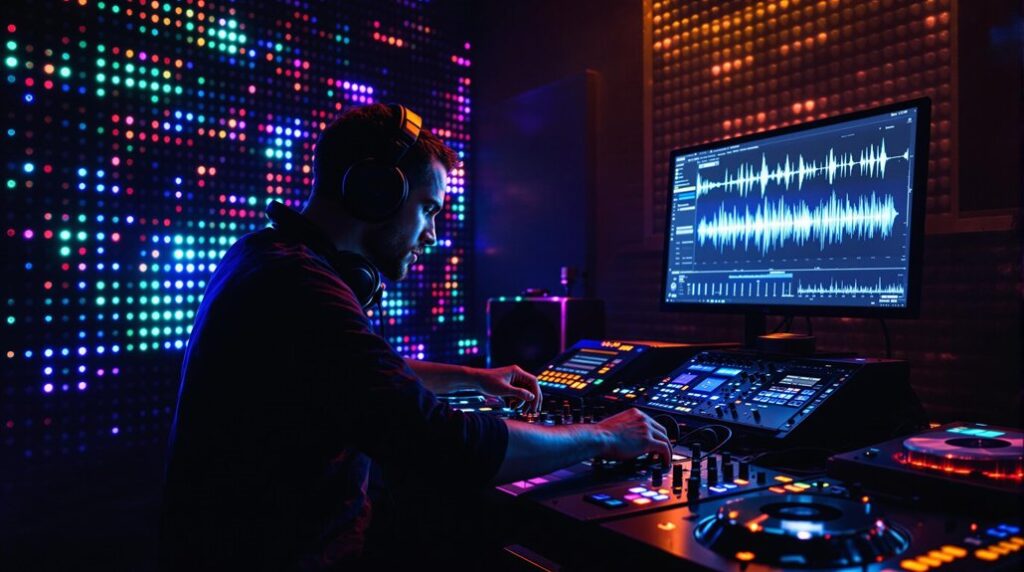A BPM finder is essential for achieving precise tempo measurement, vital for seamless track integration in music production. Advanced tools offer automatic detection, while manual tap tempo methods provide creative control. DJs and musicians benefit from understanding BPM's role in matching genres and energy. Utilizing online tools enhances accuracy, while genre-specific suggestions improve track coherence. By mastering BPM, one can enhance musical experiences and shift smoothly between tracks with ease, discovering further techniques along the way.
Key Takeaways
- Upload audio files to an online BPM finder for automatic and accurate tempo detection.
- Utilize DJ software like Rekordbox for enhanced BPM detection and mixing accuracy.
- Cross-verify automatic BPM readings using the manual tap tempo method for precision.
- Ensure audio files are high-quality to improve BPM detection accuracy and reliability.
- Organize music by BPM to facilitate seamless transitions and maintain energy in DJ sets.
Understanding the Basics of BPM
Understanding the basics of BPM, or Beats Per Minute, is fundamental for anyone involved in music production or performance. BPM measures the tempo, quantifying the rhythmic pace of a track by counting the beats occurring within a minute. For instance, a tempo of 60 BPM translates to one beat per second. Dance genres often thrive within the 120 to 145 BPM range, while hip-hop gravitates towards a slower 85 to 100 BPM. Accurate knowledge of a song's BPM is essential for DJs and musicians, facilitating seamless mixing and consistent performance tempo. BPM finder tools are indispensable in this process, offering automatic detection capabilities. Alternatively, the traditional method involves counting beats in 15 seconds and multiplying by 4 for manual BPM calculation. Understanding advanced synchronization strategies, such as harmonic mixing and tempo manipulation, can contribute to smoother transitions in DJ performances.
Importance of Calculating a Song's BPM
Calculating a song's BPM is a cornerstone in the field of music production and performance, serving as an essential tool for DJs and musicians to achieve seamless track integration.
Utilizing tempo finder tools to calculate the BPM eliminates the guesswork in timing, allowing for precise tempo matching that guarantees tracks blend harmoniously. This meticulous alignment is crucial, especially when shifting between genres with distinct BPM ranges, such as 120-145 BPM for dance or 85-100 BPM for hip-hop. Understanding these ranges enables the curator to select tracks that enhance the set's energy and cohesiveness. Additionally, producers can digitally adjust tracks slightly off tempo, refining the mix's quality.
A consistent BPM foundation allows for rearranging mixes, fostering a coherent listening experience. Incorporating harmonic mixing techniques can further enhance the transition between tracks by ensuring they are in compatible musical keys, adding depth to the auditory experience.
Exploring Different Methods for Finding BPM
Precision in music production is often grounded in accurately determining a song's BPM, which serves as the backbone for seamless track blending.
BPM finders have evolved, offering sophisticated automatic detection capabilities that analyze audio files to provide instant and precise tempo readings. This technological advancement eliminates the need for manual input, catering to both novice and seasoned producers.
Alternatively, the tap tempo method offers a hands-on approach, allowing users to tap along to a track's pulse to gauge its BPM. This method requires a keen sense of rhythm and timing to guarantee accuracy.
Both techniques are invaluable, with automatic detection being particularly efficient for processing multiple tracks simultaneously, while tap tempo grants creative control in achieving perfect synchronization.
Using Online BPM Finder Tools
Online BPM finder tools provide a dual approach to tempo analysis with options to either upload audio files for automatic BPM detection or engage in a manual tap tempo method. These tools often boast high detection accuracy, though comparisons between automatic analysis and manual tapping can reveal variances influenced by user input consistency. Such platforms not only enhance workflow efficiency by offering genre-specific BPM suggestions but also empower users with precision and adaptability in music production scenarios. Additionally, some DJ software like Rekordbox and Serato DJ Pro offer advanced track analysis which can further refine BPM detection and improve tempo accuracy in live performance settings.
Upload and Analyze Audio
For musicians, DJs, and producers seeking precise tempo data, a multitude of online BPM finder tools offer an efficient solution by allowing users to upload audio files for automatic analysis.
These platforms efficiently analyze music tracks, providing an accurate BPM reading without the tediousness of manual counting. Supporting a wide array of audio formats, users can effortlessly upload audio files from diverse sources, guaranteeing seamless integration into their workflow.
The analysis process is swift, often taking mere moments to yield BPM data vital for DJ mixing or music production. Advanced tools enhance this experience with features like key detection and tempo adjustment suggestions.
Tap for Manual Tempo
Many musicians and producers rely on the intuitive functionality of tap tempo tools to manually determine a song's BPM, offering a hands-on alternative to automated analysis.
By tapping along to the beat using online tools, users can quickly ascertain an accurate BPM reading. The key to precision lies in consistent tapping, as any deviation in rhythm can skew the results.
Online BPM finder tools often incorporate a visual metronome, allowing users to monitor tempo alignment in real-time. For enhanced accuracy, some platforms offer adjustable tap detection sensitivity, tailoring the tool to individual tapping styles.
Maintaining a steady rhythm is paramount; erratic tapping can lead to unreliable BPM measurements. Emphasizing precision and rhythm, these tools empower users to harness manual tempo determination effectively.
Compare Detection Accuracy
When evaluating the detection accuracy of BPM finder tools, it becomes evident that the choice of algorithm plays a significant role in performance.
These tools leverage automated BPM detection algorithms to parse audio files, offering results without user intervention. The fidelity of such automated BPM readings hinges on the sophistication of the model and the quality of the input audio data. Superior data sets enhance detection accuracy, producing more reliable tempo estimations.
Despite this, user-generated errors can obfuscate results when utilizing manual methods like the "tap tempo" feature, where consistent rhythm is essential. To mitigate inaccuracies, cross-referencing multiple BPM finder tools is recommended, amalgamating diverse algorithmic strengths to yield a more precise tempo determination, enhancing overall user confidence in the results.
Benefits and Limitations of BPM Finders
Although BPM finders offer a seamless way to determine a song's tempo through automated analysis, they are not without their constraints. These digital tools calculate tempo by scrutinizing audio files, delivering rapid and precise results. However, the accuracy of automatic BPM calculators can be compromised by poor audio quality or intricate rhythmic patterns, which challenge detection algorithms. Despite these limitations, BPM finders outperform tap tempo methods, which rely heavily on the user's timing proficiency and can introduce human error. While online BPM finders are generally cost-free, premium options exist that enhance capabilities with advanced analytical features and bulk track processing. Consequently, despite their occasional inaccuracies, BPM finders remain indispensable for musicians seeking efficient tempo determination and reducing manual calculation errors. Incorporating beat matching techniques alongside BPM finders can further refine the tempo synchronization process, leading to seamless transitions between tracks.
Steps to Determine BPM Manually
Determining BPM manually can be a meticulous process that requires a keen ear and precise timing. To count the number of beats accurately, one should listen intently to the song for 15 seconds. During this period, the individual taps along to the rhythm, ensuring a consistent beat count.
This number is then multiplied by four to extrapolate the BPM, providing an estimated perfect tempo. Utilizing a metronome or BPM counter app can aid in maintaining precise measurement, effectively synchronizing one's tap with the track's inherent pulse. Understanding song structure enhances the ability to anticipate changes in rhythm and predict shifts in tempo, which aids in more accurate BPM determination. A distraction-free environment is essential to avoid inaccuracies. Over time, with regular practice and familiarity with the song's rhythm, one can refine their ability to estimate BPM manually, achieving mastery without reliance on digital tools.
Popular BPM Finder Tools to Consider
In the field of digital music production, BPM finder tools emerge as indispensable assets for both amateurs and seasoned producers seeking precision in tempo alignment.
These tools, such as DJ.Studio, offer a seamless experience by providing automatic detection and manual tapping features. By allowing users to upload multiple songs, DJ.Studio calculates BPM and key with remarkable accuracy, all within an accessible online interface.
The accuracy of these BPM finders can vary, with automatic detection hinging on audio data quality, while manual tap tempo tools depend on user precision.
Some platforms offer free access, while others provide advanced features for a fee. Utilizing metronomes or BPM counter apps can enhance the precision of BPM readings across diverse tempo ranges.
Techniques for Using Tap Tempo Tools
How can producers enhance BPM accuracy with tap tempo tools? Precision begins with maintaining a consistent tapping rhythm, a fundamental requirement to calculate the BPM effectively.
By tapping accurately along to the beat, users allow tap tempo tools to translate physical rhythm into numerical tempo seamlessly. Incorporating visual metronomes or feedback mechanisms helps users synchronize their taps with the music, ensuring precise results.
For instance, tapping over a 15-second interval and multiplying taps by four offers a reliable BPM estimate. This method is particularly advantageous for tracks exhibiting variable tempos or intricate rhythms.
Consequently, using tap tempo tools enhances BPM detection accuracy, providing producers with a robust framework for achieving ideal tempo alignment in their creative projects.
How to Analyze BPM for Multiple Songs
Building on the precision offered by tap tempo tools, analyzing BPM for multiple songs necessitates a strategic approach. Utilizing a BPM Finder that supports batch uploads streamlines simultaneous tempo analysis.
High-quality audio files are essential to guarantee accurate BPM detection, as data integrity directly impacts results. For enhanced utility, consider BPM Finder tools that offer key detection, enriching the music library's categorization and facilitating seamless playlist curation.
Here's a structured methodology:
- Batch Processing: Use a BPM Finder for bulk uploads to efficiently analyze BPM across numerous tracks.
- Quality Assurance: Confirm audio files are pristine to maximize the accuracy of BPM calculations.
- Cross-Verification: Leverage tap tempo features to validate automatic readings, particularly for tracks with intricate rhythms, ensuring a consistent BPM framework.
Regularly updating your DJ library is crucial to maintaining relevance and ensuring your playlists reflect the latest music trends and audience preferences.
Integrating BPM Data for DJ Mixing
Efficient integration of BPM data into DJ mixing not only guarantees smooth shifts but also maintains the desired energy level throughout a set. DJs leverage BPM finders to accurately ascertain the tempo of each track, facilitating seamless alterations. By organizing their music library by BPM, they can easily pinpoint tracks with compatible tempos, ensuring cohesive mixing. The industry standard suggests targeting tracks within a 5 BPM range for alterations, minimizing abrupt tempo changes that might disrupt flow. Digital tools enable subtle tempo adjustments, allowing DJs to refine alterations and enhance audience engagement. Utilizing BPM data not only aids in mixing but also empowers DJs to craft playlists that align with specific genres or moods, enhancing the overall experiential dynamic of a set. Additionally, incorporating harmonic mixing principles ensures not only tempo compatibility but also key compatibility, resulting in an emotionally impactful and fluid listening experience.
Tips for Curating Playlists Based on BPM
Utilizing BPM data is not solely the domain of live DJ sets; it is equally instrumental in curating dynamic playlists. By categorizing tracks into specific BPM ranges, one can guarantee a cohesive auditory experience and maintain desired energy levels. For instance, a key finder can assist in identifying tracks within the 120-130 BPM range, ideal for dance playlists.
- Tailor to Activities or Moods: For workouts, choose songs within the 120-180 BPM range to sustain motivation.
- Smooth Shifts: Limit BPM differences to 10-15 between consecutive tracks for seamless mixing.
- Explore Genre-specific BPMs: Utilize online resources to adhere to genre standards, like 85-100 BPM for hip-hop.
Regular updates with a BPM finder keep playlists fresh and engaging across different genres. By integrating AI technologies, DJs can automate transitions and enhance their creative possibilities, ensuring an ever-evolving and dynamic playlist experience.
Enhancing Music Production With Accurate BPM
Accurate BPM detection is a key component in music production, enabling producers to maintain genre-specific tempo standards while enhancing track cohesiveness. Advanced BPM finder tools offer precise tempo analysis, essential for seamless track blending and effective audience engagement. Additionally, utilizing advanced key detection enables producers to create harmonically matched mixes, further improving the overall quality and fluidity of transitions.
Importance of Accurate BPM
In the field of music production, precise BPM (beats per minute) calculations stand as a cornerstone for crafting seamless auditory experiences.
Accurate BPM calculations are instrumental in finding the right tempo, which facilitates flawless shifts between tracks, enhancing the cohesiveness of any set or playlist. This precision is crucial for DJs and producers aiming to optimize energy flow and captivate their audience.
- Seamless Shifts: Accurate BPM guarantees smooth track changes, maintaining rhythm continuity.
- Enhanced Mixing: Knowing precise BPM reduces guesswork, leading to superior arrangement and mixing.
- Creative Experimentation: Accurate measurements allow musicians to explore tempos that align with their artistic vision.
Ultimately, these calculations are critical in aligning audio components, guaranteeing perfect synchronization of instruments and vocals.
Tools for BPM Detection
BPM detection tools serve as vital assets in the arsenal of music producers and DJs, automating the process of tempo identification to guarantee accuracy in mixing and production. Utilizing sophisticated BPM Finder algorithms, these tools analyze audio files, offering instant tempo readings that streamline workflow.
For those seeking versatility, online BPM Finder services allow batch processing, enabling users to upload multiple tracks simultaneously, thereby optimizing time management for DJs and producers.
While automatic BPM detection provides speed, integrating manual methods such as tap tempo tools and manual counting enhances accuracy. By tapping along to the beat, users can verify automated results, although precision depends on consistent timing.
Combining these methodologies guarantees a robust approach to BPM detection, essential for crafting seamless and dynamic music experiences.
BPM Impact on Mixing
Seamless changes in DJ sets and music production often hinge on the precise alignment of beats, a feat best achieved through meticulous BPM (beats per minute) management.
Accurate BPM calculations are essential in mixing, enabling DJs to blend tracks without disrupting the tempo, thereby maintaining the set's energy flow. This precision fosters an immersive auditory experience and enhances audience engagement.
- Enhanced Coherence: By rearranging mixes based on similar tempo ranges, performers guarantee continuity and harmony throughout their performances.
- Efficiency: Automatic BPM detection eliminates manual counting, allowing producers to dedicate more time to creative processes.
- Audience Connection: Aligning tracks with listeners' rhythmic preferences guarantees a mesmerizing, enjoyable experience.
In essence, BPM accuracy is not just a technical necessity but a creative enabler in the art of mixing.
Frequently Asked Questions
How Do I Find the Right Tempo?
To determine the right tempo, one should examine tempo variations across musical genres. Employ rhythm techniques to experiment with beats per minute (BPM), ensuring alignment with the track's emotional intent and energy, while utilizing industry-standard tools for precision.
How Do I Know What BPM I Should Use?
Determining the ideal BPM involves understanding its significance on a track's energy. Genre influence dictates standard tempos, yet personal preference allows creative flexibility. Combining technical analysis with artistic intuition guarantees a BPM that complements the music's intent.
How Will I Know Tempo BPM?
Tempo identification techniques vary, influenced by music genre preferences. Digital tools comparison highlights automatic BPM finders, tap tempo functions, and DAW-integrated options. These methods offer precise tempo insights, aiding musicians and DJs in crafting rhythmically cohesive tracks.
What Tempo Marking Is 130 BPM?
A tempo marking of 130 BPM is categorized as "Allegro," reflecting its energetic pace. Its bpm significance spans multiple tempo genres, fostering dynamic musical expression in pop, dance, and EDM, pivotal for creating lively and engaging tracks.
Conclusion
In the domain of music production and DJing, mastering BPM analysis is essential for seamless changes and crafting dynamic sound environments. By utilizing online BPM finder tools, professionals can efficiently determine tempo, ensuring cohesive playlist curation and precise mixing. While these tools offer convenience, understanding their limitations is significant for accuracy. Integrating BPM data not only enhances auditory experiences but also optimizes creative workflows, allowing artists to innovate and uplift their compositions in an increasingly competitive industry framework.




